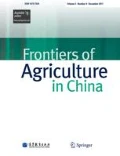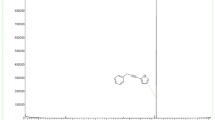Abstract
Apriona germari is a destructive stem-boring pest. To date, the control of the pest is still based largely on the chemical insecticides. To meet the needs of people’s high pesticide efficacy and environment safety, the alternative management strategy must be proposed. Beauveria bassiana is one of the most widely studied and used entomopathogenic fungi. The potential of Beauveria bassiana used to control Apriona germari was here evaluated. The result showed that the infective rate of B. bassiana to adults was 20%, with no pathogenicity to eggs. But it showed a high pathogenicity to larvae. The laboratory bioassays showed that the mortality, when concentration was 1 × 108 conidia/mL, was 96.47% ten days after inoculation. LT50 of B. beauveria to Apriona germari larvae was 4.53 d at the concentration of 1 × 108 conidia/mL; LC50 was 6.76 × 105 conidia/mL. The infecting experiments in field showed that, 20 days after control, the mortality was 68.4%. The present results suggested that B. bassiana has an excellent potential for biological control of A. germari larvae.
Similar content being viewed by others
References
Bextine B R, Thorvilson H G (2002). Field application of baitformulated Beauveria bassiana alginate pellets for biological control of the red imported fire ant (Hymenoptera: Formicidae). Environmental Entomology, 31(4): 746–752
Ding D G, Li Z Z, Fan M Z, Wang B (2004). Host transfer of Beauveria bassiana population in pine stand ecosystem and impact of its genetic diversity on sustainable control of Masson’s pine caterpillars. Journal of Applied Ecology, 15(12): 2315–2320 (in Chinese)
Dubois T (2003). Biological control of the Asian longhorned beetle, Anoplophora labripennis, with entomopathogenic fungi. Dissertation for the Doctoral Degree. New York: Cornell University, 200
Dubois T, Hajek A E, Hu J F, Li Z Z (2004a). Evaluating the efficiency of entomopathogenic fungi against the Asian longhorned beetle, Anoplophora glabripennis (Coleoptera: Cerambycidae), using cages in the field. Environmental Entomology, 33(1): 62–74
Dubois T, Li Z Z, Hu J F, Hajek A E (2004b). Efficacy of fiber bands impregnated with Beauveria brongniartii cultures against the Asian longhorned beetle, Anoplophora glabripennis (Coleoptera: Cerambycidae). Biological Control, 31(3): 320–328
Felipe T, Mario Z, Raquel A, Juan C, David S (2004). Pathogenicity of Beauveria bassiana (Deuteromycota: Hyphomycetes) against the cactus weevil, Metamasius spinolae (Coleoptera: Curculionidae) under laboratory conditions. Florida Entomologist, 87(4): 533–536
Feng M G, Poprawski T J, Khachatourians G G (1994). Production, formulation and application of the entomopathogenic fungus Beauveria bassiana for insect control: Current status. Biocontrol Science and Technol ogy, 4(1): 3–34 (in Chinese)
Guo Z H, Cui Y S, Yang H P, Li L Z (2001). Applied Technique of Beauveria brongniatii against Holotrichia diomphalia in Nurseries. Journal of Northeast Forestry University, (6): 32–35 (in Chinese)
He X Y, Chen S L, Huang J S (2005). Preliminary screening of virulent strains of Metarhizium anisopliae against Monochamus alternatu. Acta Entomologica Sinica, 48(6): 975–981 (in Chinese)
He Y W (2010). Review of Research on Beauveria bassiania. Heilongjiang Agricultural Science, (4): 145–147 (in Chinese)
Lacey L A, Frutos R, Kaya H K, Vail P (2001). Insect pathogens as biological control agents: Do they have a future? Biological Control, 21(3): 230–248
Li H P, Huang D Z, Wang X H, Zheng J W (2006). Isolation of Beauveria bassiana using “Tenebrio molitor Bait Method” and screening of high virulent strains against Apriona germari larvae. Acta Sericologica Sinica, 32(3): 320–323 (in Chinese)
Lin Q Y (2005). Selection and application of Beauveria bassiana to control Tessaratoma papillosa. Forest Research, 18(2): 143–146 (in Chinese)
Liu H M, Sun X G, Wang X J (2002). Advances in the research on Apriona germari Hope. Forest pest and disease, 21(5): 30–33 (in Chinese)
Liu H J, Piao C G, Wang L F, Shen S C, Shu Q L (2007). Biocontrol of Monochamus alternatus by Beauveria bassiana and Scleroderma guani. Scientia Silvae Sinicae, 43(5): 64–68 (in Chinese)
Liu H J, Shu Q L, Wang L F, Piao C G, Fang J M, Dong G P (2009). Research on the biocontrol of Monochamus alternatus larvae by Beauveria bassiana with several synergists. Forest Research, 22(5): 652–656 (in Chinese)
Lu X J, Li R J, Dong L X, Dong J Z, Zhao H L, Tao B (2008). The screening of high toxicity Beauveria strains against Hyphantria cunea (Drury) and compatible with cypermethrin. Acta Phytophylacica sinica, 35(6): 575–576 (in Chinese)
Pu Z L, Li Z Z (1996). Insect Mycology. Hefei: Anhui Science & Technology Press (in Chinese)
Shimazu M (2004). A novel technique to inoculate conidia of entomopathogenic fungi and its application for investigation of susceptibility of the Japanese pine sawyer, Monochamus alternatus, to Beauveria bassiana. Applied Entomology and Zoology, 3(39): 485–490 (in Japanese)
Shimazu M, Sato H (1995). Microbial control of the pine sawyer, Monoohamus alternatus by Beauveria bassiana. In: International Symposium on PineWood Nematode. Beijing, China, 128–137
ST Leger R J, Screen S (2001). Prospects for strain improvement of fungal pathogens of insects and weeds. In: ST Leger R J. Fungal as Biocontrol Agents. London: CABI Publish House, 219–237
Sun L J, Wu K M, Guo Y Y (2001). The pathogenicity of Beauveria bassiana to Helicoverpa armigera under different temperatures and humidities. Acta Entomologica Sinica, 44(4): 501–506 (in Chinese)
Wang Y B, Dong J Z, Song R M, Li R J, Li J, Lu X J (2007). The screening virulent strain of Beauveria bassiana to Laphygma exigua Hubner. Chinese Agricultural Science Bulletin, 23(5): 346–348 (in Chinese)
Wraight S P, Carruthers R I (1999). Production, delivery, and use of mycoinsecticides for control of insect pests of field crops. In: Hall F R, Menn J J, eds, Methods in Biotechnology. Totowa N J: Humana Press, 233–270
Wu Z K, Li Z Z (1996). Application of Beauveria. In: Pu Z L, Li Z Z, eds, Insect Mycology. Hefei: Anhui Publishing House of Science and Technology, 387–392 (in Chinese)
Xu J H, Feng M G, Tong X M (2003). Screening of conidia germination stimulus as an additive to Beauveria bassiana formulation to enhance its efficacy for aphid control. Acta phytophylacica Sinica, 30(1): 45–50 (in Chinese)
Zhang AW, Liu WZ, Nong X Q (1992). The development of Beauveria bassiana wettable powder. Chinese Journal of Biological Control, 8(3): 118–120 (in Chinese)
Zhang B, Inoue (1999). Microbial control of Anoplophora glabripennis adults by application of non-woven fabric strips with Beauveria bassiana and B. brongniartii. Journal of Northwest Forestry University, 14(1): 68–72 (in Chinese)
Author information
Authors and Affiliations
Corresponding author
About this article
Cite this article
Li, H., Huang, D. & Wang, Z. Potential of Beauveria bassiana for biological control of Apriona germari . Front. Agric. China 5, 666–670 (2011). https://doi.org/10.1007/s11703-011-1130-2
Received:
Accepted:
Published:
Issue Date:
DOI: https://doi.org/10.1007/s11703-011-1130-2




